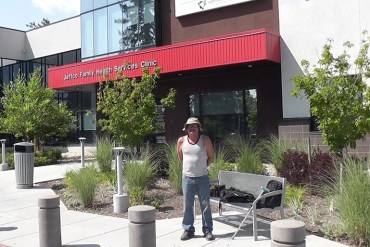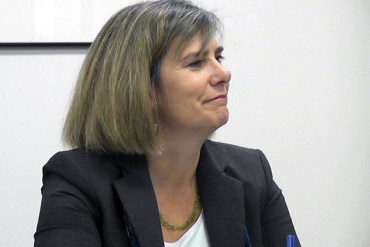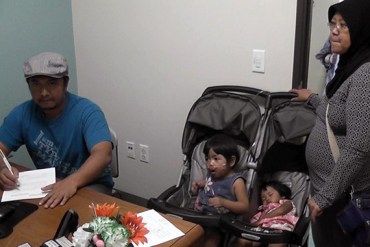Colorado’s uninsured rate has plummeted from a recent high of 15.8 percent four years ago to 6.7 percent this year, and the success of the Affordable Care Act in Colorado is almost entirely the result of Medicaid expansion, according to a much anticipated survey from the Colorado Health Institute.
The survey found that nearly one in three of the state’s 5.3 million residents now get insurance through Medicaid or other public health insurance programs.

New Medicaid recipient Marty Rieger of Lakewood, Colo. stands outside the new clinic where he gets care. In the Colorado county where Rieger lives, a record number of uninsured have received care over the last two years. (Photo by Katie Kerwin McCrimmon, Health News Colorado)
With nearly 1.3 million Coloradans now on Medicaid, the state has the fourth fastest-growing Medicaid program in the country behind Kentucky, Oregon and Nevada, according to an analysis earlier this year from the federal Centers for Medicare & Medicaid Services.
The surge of Medicaid recipients in Colorado shattered Gov. John Hickenlooper’s 2013 projection that the state would add about 160,000 new Medicaid clients over 10 years without costing the state budget “a single dollar.”
According to the Colorado Health Access Survey, the state has 450,000 more Medicaid recipients in 2015 than in 2013. In states that expand their Medicaid programs under the health law, nearly all low-income Americans with incomes up to 138 percent of poverty ($16,242 per year for an individual in 2015) would qualify. Pregnant women and children in families with higher incomes — up to 260 percent of the federal poverty level or $60,700 for a family of four — can qualify for the Child Health Plan Plus in Colorado.
State officials are highlighting Colorado’s success, saying the state is close to covering everyone. In particular, they cited a major drop in the number of children who remain uninsured, from about 7 percent to 2.5 percent.
“Colorado is a state that has done what it set out to do. We got more people insured,” said Michele Lueck, president and CEO of the Institute, a research group. Analysts conducted the survey of 10,146 randomly selected households, including landlines and cell phones. The poll was conducted after open enrollment ended, between March 2 and June 26.
Sue Birch, executive director of Colorado’s Medicaid programs, downplayed the governor’s much lower projections for Medicaid expansion.

Sue Birch, executive director of Colorado’s Medicaid programs, says she and Gov. John Hickenlooper stand by their promise that Colorado taxpayers will not have to spend extra money to pay for a major influx of new Medicaid patients. (Photo by Katie Kerwin McCrimmon, Health News Colorado)
“The most important thing is that people got covered,” Birch said.
She said she and the governor stand by the promise that over 10 years, Medicaid programs will save enough money to cover the cost of additional patients.
“Health care transformation is an investment in time and the right strategies. Colorado has made the right choices and they are starting to pay dividends,” Birch said.
She said preventive care among patients is up, total cost of care per person is down 9 percent since Medicaid expansion started, more providers are stepping up to care for Medicaid patients and people with chronic conditions are getting better primary care.
“This was an invisible population,” Birch said. “Colorado’s story is about all this movement toward health.”
Most states that have expanded Medicaid have found that they guessed far too low, said Matt Salo, executive director of the National Association of Medicaid Directors.
“It’s hard to forecast what actually happens when you change a lot of pieces in an interconnected health care system,” Salo said. “A lot of states are finding that they’re enrolling more people (who qualify for Medicaid) than they assumed lived in the state.”
Those states include Colorado, Washington, Oregon, Kentucky and Ohio, Salo said.
“When you’ve got a state like Colorado that really puts its shoulder behind Medicaid expansion and expansion in coverage is something you go all in on, you’re going to see significant impacts,” he said.
Thus far, 31 states including the District of Columbia have expanded Medicaid and even in a place like Ohio with a Republican governor running for president, there is no sign of backpedaling, Salo said.
“There have been very, very few examples where a big expansion has been followed by a big retraction,” he said. “Once you’ve actually given insurance to hundreds of thousands of people who didn’t have it before, taking it away is a very real thing.”
While many patients with new coverage welcome the chance to see doctors, skeptics say Colorado taxpayers will have to pay dearly for the ballooning Medicaid population starting in 2017 when the federal government no longer picks up the full tab for new clients. Federal assistance falls to 95 percent that year and gradually decreases until it reaches 90 percent in 2020.
“You didn’t have to be a brain surgeon to see this coming,” said Sen. Ellen Roberts, a Republican from Durango, Colo., who tried to persuade the governor in 2013 not to add so many people to the Medicaid rolls all at once. “We’re putting Medicaid expenditures on a collision course with every other state expenditure, from K-12 (education) to highways to higher education. Medicaid is just consuming our state budget.”

Yanto, left, a student from Indonesia studying at the University of Colorado, signs up his pregnant wife, Nachiyati, for Medicaid. Their two daughters, born in the U.S., both receive Medicaid while the family is living in Colorado. Almas, 2 1/2, was born with a congenital heart condition, but is doing much better after surgery and soon will be off oxygen. (Photo by Katie Kerwin McCrimmon, Health News Colorado)
The survey, which the Institute conducts every other year, also found that Colorado’s health exchange for individuals buying private insurance failed to capture the majority of that market. Despite spending nearly $200 million in federal funds on start-up costs and IT systems that have thus far been full of glitches, Connect for Health Colorado accounts for just 42 percent of the individual market; the number of individuals signing up for private health insurance in the individual market has stayed roughly the same since before the Affordable Care Act launched — about 409,000.
Other trends emerging from the Colorado Health Access Survey parallel those around the country:
- California and Ohio data show dramatic drops in their uninsured rates. The Gallup survey found the sharpest declines in states that expanded Medicaid. Obama administration officials in August said the uninsured rate dropped nationally to 9.2 percent, from 14.4 percent in 2013.
- The percentage of people getting health insurance through their jobs has fallen from nearly 58 percent in Colorado in 2009 to 51 percent this year. More large employers in Colorado are providing health insurance, while small businesses are dropping coverage.
- Gaps in coverage include undocumented workers who don’t qualify and people living in ski resort regions and rural western Colorado, many of whom say health coverage costs too much.
- Nearly 12 percent of Hispanics in Colorado still don’t have insurance, compared to about 5 percent among others.
- In a surprise finding, Colorado hipsters in their 30s are skipping health insurance at even higher rates than those in their 20s. In both cases, about one-quarter of so-called young invincibles used to be uninsured. While many more now have coverage, 12.9 percent of twenty-somethings and 13.4 percent of thirty-somethings still are not buying health insurance.
- The high cost of health insurance is by far the biggest reason people cite for skipping coverage.
- While the ranks of the uninsured have dropped a lot in Colorado, those who are “underinsured”— meaning they don’t have enough coverage to pay for expensive health care problems — has continued to grow over the past four years. Low-income people have the highest rates of being underinsured as do those who buy their insurance on the individual market.
Sen. Roberts chairs a legislative oversight committee that will start considering legislation this month about whether to keep Colorado’s exchange or consider folding it into the federal exchange. The biggest complaint Roberts hears from residents in her area in southwestern Colorado is that people qualify for Medicaid, but don’t want it because they can’t find providers who will care for them.
On the other hand, in Jefferson County in the Denver metropolitan area, health professionals were ready for the surge of new Medicaid clients. In Wheat Ridge, patients are getting care in a polished new community health center where they receive integrated physical, mental health and dental services all in one place.
Jefferson County hugs the foothills west of Denver and is the state’s fourth most populous county. There, the uninsured rate dropped a stunning 75 percent in just two years from 11.6 percent to 2.8 percent. That was the largest decrease statewide, according to the survey; analysts found that about 50,000 fewer people are now uninsured in Jefferson County than in 2013.
Many are new Medicaid recipients, including Michael Goffinett, 53, of Lakewood.
He used to have insurance with his job as a fire restoration worker. Then he lost his job and need back surgery. First he got Medicaid and started going to the Wheat Ridge clinic. Now his wife and son also get coverage through Medicaid.
“It’s been a great help for me and my family. They’re always there for me,” Goffinett said as he braved his fears of dental care and had a cavity filled recently at the nonprofit Metro Community Provider Network’s Wheat Ridge clinic.
“They’re good,” Goffinett said of his doctors. “If you have a job or you don’t have a job, they take care of you. No hassles.”
Goffinett’s dentist, Dr. Fatima Kazi, had a waiting list of more than 200 patients when she started working at the Jefferson Family Health Services Center in December.
She had previously worked at other public health clinics in Colorado and welcomed the chance to practice at the big new clinic full of large windows, natural light and state-of-the art equipment.
“It’s beautiful,” Kazi said. “It’s comprehensive care in one place. That’s what makes a lot of public health successful. Patients only have to come to one location and they can get most of their treatment in one location.
“Part of the reason I do public health is that I believe everybody should have access to health care,” Kazi added. “Dentistry is not cheap. You can choose not to take care of your teeth and end up in the emergency room.”
She said having easily accessible dental care side-by-side with primary care makes it much easier for patients like Goffinett to come. He hadn’t seen a dentist in several years, but started having pain and his doctors sent him to the dentists.
As Kazi worked on his teeth, Goffinett fidgeted and kept asking if she was done.
“It’s the first time I’ve really dealt with my teeth. I love my dentist, but I don’t like going,” he said.
In the mental health section of the clinic, children with severe problems have group sessions with therapists while adults get help from peer counselors who have struggle with schizophrenia and other challenges themselves.
John Reid, vice president of fund development for the Metro Community Provider Network, credits the clinic’s CEO with having the foresight to brace for the surge in patients in Jefferson County and the other suburbs that surround Denver. The network got federal and local grants of more than $13 million to buy the land and open the Jefferson Family Health Services Center in Wheat Ridge in 2013. As the network finds and hires providers, it can treat more people and expects to serve about 10,000 patients at the center when it’s full.
Altogether, the network boasts 23 safety-net clinics, 10 of which are in Jefferson County. Last year, the network served nearly 43,000 patients. Some of the clinics are in schools while others are partnerships with the Jefferson Center for Mental Health.
The bump in Medicaid patients has been huge, Reid said. Previously about one-third of network patients qualified for Medicaid. Most of the rest were uninsured. Now nearly two-thirds of patients have Medicaid.
Reid said all the networks clinics are seeing thousands of new patients. They serve them regardless of their insurance status. Many are undocumented immigrants who can’t qualify for Medicaid.
“We want to be fiscally and financially sound. At the same time, we’re a community partner. We want to do what’s in the best interest of each and every patient, every touch every time. That’s our motto and we really live by that credo,” Reid said.
With the rush of patients in Jefferson County, some are arriving with severe problems.
Jamie Vader, a physician’s assistant at the Wheat Ridge Clinic, cared for a 61-year-old woman who arrived last week with severe abdominal pain. Vader and a student working with her did an extensive history and suspected more than the first-brush diagnosis of a bladder infection. They feared possible cervical cancer.
Tests showed they were right. The woman came back two days later. She was devastated, but the clinic set her up with a specialist to treat the cancer along with mental health care and a care coordinator to help her navigate the many appointments she’ll now need.
“It’s been over 10 years since she had any well care. Had she gotten care then, she wouldn’t have cancer,” Vader said.
The woman’s prognosis is not good since her cancer is so advanced.
While it’s good that people are getting coverage now, Vader said she’s seeing many sad cases.
“You have to clean it up first,” she said “We’ve always had a lot of really sick people. There are just more of them.”







